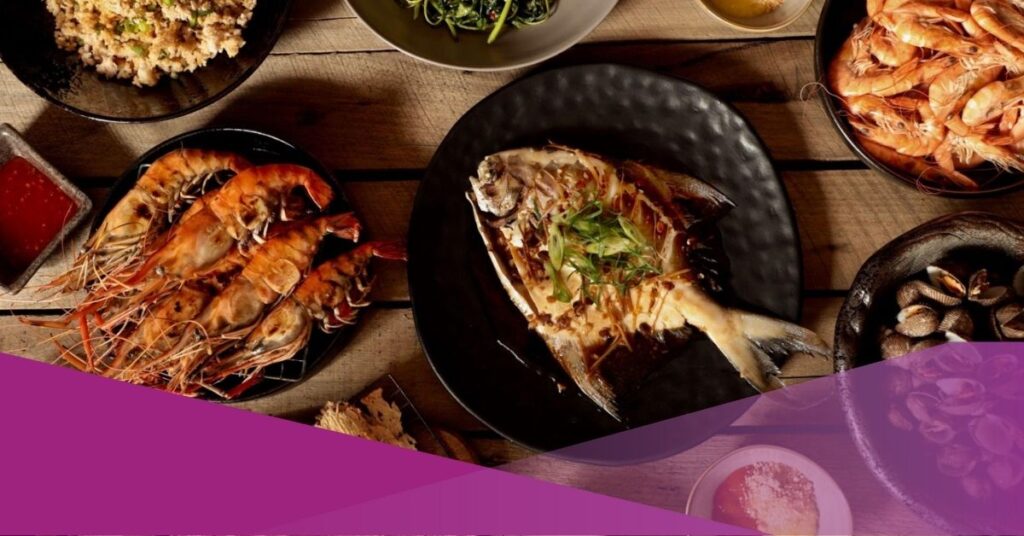Indonesian food known for its diverse culinary heritage, has a delectable selection of seafood dishes. Indonesian seafood cuisine is a sensory feast, with traditional recipes passed down through generations and modern twists on classic favourites. Indulge in the finest Indonesian seafood dishes, expertly grilled and seasoned with local spices.
Each seafood dish, from succulent fish to delectable shellfish, is a flavour explosion. Whether you enjoy seafood or simply want to sample the best of Indonesian cuisine, these popular Indonesian fish recipes will leave you wanting more. Prepare to be wowed by the delectable delights of an authentic Indonesian seafood feast!
The rich seafood culture in Indonesian food
Overview of Indonesian seafood dishes
Indonesian seafood dishes are known for their bold flavours and unusual pairings that makes Indonesian food more diverse. One of the most well-known dishes is “gurame bakar,” which is a grilled gourami fish marinated with a spice blend and served with a spicy sauce. “Sate udang,” skewered grilled prawns marinated in a sweet and savoury sauce, is another popular dish.
“Kangkung cah kepiting” (stir-fried water spinach with crab) and “tauge udang” are two other seafood dishes (stir-fried bean sprouts with prawns). These dishes highlight the many different flavours and ingredients found in Indonesian cuisine.
Importance of seafood in Indonesian culture and culinary traditions
Indonesia has a rich seafood culture and culinary traditions. Seafood is an important part of Indonesian cuisine, with many recipes highlighting the country’s diverse marine resources. Seafood is revered for its distinct flavours and textures, from aromatic fish curries to grilled prawns. Indonesian households take pride in using fresh, locally sourced seafood to prepare delectable dishes enjoyed by both locals and tourists. Seafood is not only a culinary delight, but it also represents Indonesia’s cultural heritage.
Popular Indonesian seafood dishes
Ikan Bakar
Ikan Bakar, or grilled fish, is a popular Indonesian food with tantalising flavours. Whole fish, such as snapper or mackerel, are typically marinated in a blend of spices such as garlic, shallots, ginger, lemongrass, turmeric, and aromatic herbs.
The fish is then grilled over hot charcoal or an open flame, which gives it a smoky, slightly charred flavour. The skin of the fish crisps up while the flesh remains moist and tender, creating a delightful texture contrast.
Ikan Bakar variants can be found throughout Indonesia, with each region adding its own spin. In Bali, the marinade may include regional spices, whereas Andaliman, a citrusy local spice, is frequently used in North Sumatra. Different types of fish can be used, and the accompanying sambal can vary in spiciness and ingredients, making it a versatile dish.
Kepiting Saus Padang
Kepiting Saus Padang is a traditional Indonesian seafood dish that features mud crab as the main ingredient. The dish is from Padang, West Sumatra, and it has a spicy sauce made of aromatic spices and chilli. The crab is cleaned and prepared, and the sauce is combined, allowing flavours to permeate the crab meat. Slowly simmering the dish allows the crab to absorb the rich flavours, resulting in a tender and spicy crab dish.
Lemongrass, galangal, and kaffir lime leaves add a refreshing citrusy aroma, while the crab’s umami notes create a harmonious balance of heat and savoury flavours, making it a beloved and satisfying seafood delicacy in Indonesian cuisine.
Udang Saus Tiram
Udang Saus Tiram is a traditional Indonesian seafood dish that features succulent prawns cooked in savoury oyster sauce. Fresh, deveined prawns are marinated in garlic, ginger, and soy sauce before being stir-fried in a wok and coated with oyster sauce.
The dish features a delectable blend of flavours and textures, with prawns providing a juicy and tender bite, garlic and ginger adding aromatic warmth, shallots adding a subtle sweet note, and soy sauce adding saltiness and depth. Overall, Udang Saus Tiram demonstrates the skill of using oyster sauce to enhance the natural flavour of prawns in Indonesian cuisine.
Pempek
Pempek is a traditional Indonesian food from South Sumatra that consists of a fish-based dough and a savoury, tangy sauce. Mackerel or Spanish mackerel, tapioca starch, garlic, salt, and water are the main ingredients. Deboned fish is ground into a paste with tapioca starch, garlic, salt, and water. Before frying or serving, the dough is formed into cylinders or balls, boiled in hot water, and cooled.
The delicate fish flavour of Pempek is enhanced by a crispy outer layer. It is frequently served with a sweet and sour sauce known as “cuko,” which complements the dish’s mild umami flavour. Overall, eating pempek is a delectable culinary experience.
Bandeng Presto
Presto Milkfish, also known as Bandeng Presto, is a popular Indonesian food made from milkfish (bandeng). The dish is distinct because of the pressure-cooked method, in which the fish is pressure-cooked until the bones become tender and edible.
Fresh milkfish, aromatic spices like garlic, shallots, turmeric, ginger, and candlenut, as well as tamarind, bay leaves, and salt, are key ingredients. The pressure cooking technique shortens the cooking time and softens the bones of the fish, making it edible and enjoyable to eat. Bandeng Presto is a delectable blend of flavours and textures, with the tender milkfish absorbing the spices to create a savoury and fragrant flavour.
The tamarind adds a tangy note to the richness. Typically, the dish is served with steamed rice, fresh vegetables, or a spicy sauce.
The culinary heritage of Indonesian seafood dishes
Indonesian seafood dishes reflect the country’s diverse culinary traditions as well as its abundant natural resources. Indonesia’s diverse ecosystems provide a diverse range of seafood options, each with its own distinct flavour.
The preparation and flavours of seafood dishes have been influenced by the country’s maritime trade and exploration, reflecting its rich biodiversity and connection to the seas. Sharing meals and seafood feasts are culturally significant, preserving Indonesia’s maritime heritage and attracting both tourists and locals.
Conclusion
Finally, the journey from grill to table provides an exquisite opportunity to savour the finest Indonesian seafood dishes, each of which is a tantalising showcase of the country’s rich culinary heritage. Home cooks can recreate the authentic flavours that have delighted palates for generations by sourcing the freshest seafood, infusing dishes with traditional Indonesian spices and seasonings, and using the right cooking techniques and equipment.
These seafood delicacies offer a symphony of tastes and textures, from the smoky allure of Ikan Bakar to the aromatic allure of Bandeng Presto and the indulgent delights of Kepiting Saus Padang. Begin this flavorful journey and discover the gastronomic delights that await, celebrating the art of Indonesian seafood from grill to table. Happy eating!
If you’re curious about more Indonesian signature delicacies, check out these articles below:








































